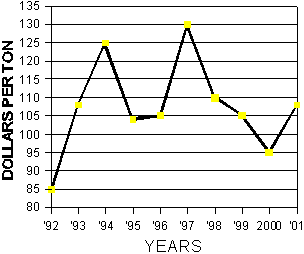Alfalfa Report
Yuma County, Arizona
April 23, 2001
Yuma County Office
2200 W. 28th Street, Ste. 102
Yuma, AZ 85364
(520) 726-3904
(520) 726-8472 FAX
Production Update:
PDF version, 14KB
Hay Preservatives (Part 3): Microbial hay preservatives or inoculants are available in addition to chemical preservatives. Microbial preservatives are not corrosive to equipment, as is the case with most chemical preservatives, and may be naturally occurring and derived from hay. The beneficial bacteria in hay inoculants stabilize high moisture hay and prevent heating, mold growth, and dry weight loss caused by harmful microbes.
Insect Management: In alfalfa grown for hay, spider mites infestations are usually confined to the lower leaves. Serious damage to hay fields historically has been associated with water stress. When infested fields were watered, the problem usually cleared up in a few days. Spider mite damage is becoming more common in low desert alfalfa. Pyrethroid insecticides have been implicated as the cause for secondary mites outbreaks in alfalfa, but a clear cause and effect relationship has not been established. Damage starts in the lower plant canopy moving upward. Spider mites feed on plant sap by inserting long needlelike mouth parts into leaves. Leaves are covered with webbing, become stippled with chlorotic spots and turn yellow. Severe feeding causes leaf desiccation and defoliation. Feeding damage can reduce yield, quality and retard regrowth. Definitive monitoring and treatment guidelines have not been developed because spider mites are a sporadic problem in alfalfa grown for hay. When possible avoid using the pyrethroid insecticides to control alfalfa hay pests. Damaging populations are most commonly encountered under stress conditions. Minimizing crop stress through improved irrigation practices. Chemical control of spider mites in alfalfa hay is usually not recommended. When severe infestations occur, sulfur may be used to suppress the mite population.
Weed Control: It will take three years of the highest label rate
of Zorial to control nutsedge. The highest labeled rate is probably too
low and suppression only is likely. After three years of use, rotating
to many sensitive crops will not be possible.
| Market Summary |
High
|
Low
|
Average
|
Off grade
|
| Past 2 Weeks (Apr. 9 to Apr. 22, 2001) |
115
|
100
|
108
|
90-100
|
| Last Year (Apr. 9 to Apr. 22, 2000) |
100
|
90
|
95
|
70-90
|
10 Year Summary (April 9, to April 22, 1992 - 2001):

Issued in furtherance of Cooperative Extension work, acts of May 8 and June 30, 1914, in cooperation with the U.S. Department of Agriculture, James A. Christenson, Director Cooperative Extension, College of Agriculture and Life Sciences, The University of Arizona.
The University of Arizona is an equal opportunity, affirmative action institution. The University does not discriminate on the basis of race, color, religion, sex, national origin, age, disability, veteran status, or sexual orientation in its programs and activities.
Any products, services, or organizations that are
mentioned, shown, or indirectly implied in this web document do not imply
endorsement by The University of Arizona.
Information provided by:
Barry Tickes, btickes@ag.arizona.edu Extension Agent, Yuma County
Michael Ottman, mottman@ag.arizona.edu Agronomy Specialist
College of Agriculture, The University of Arizona.
Eric Natwick, etnatwick@ucdavis.edu UCCE Imperial County - Farm Advisor
University of California, Davis, CA.
Material written April 23, 2001.
Forages: Crop Mgmt | Soil Mgmt | Irrigation | Alfalfa Reports | Insects | Diseases | Weeds | Pesticides
Home | Other Crops | Forages
For more Arizona Production Ag Information:
Home | Cotton | Veggies| Forages | Grains | Citrus | Crop x Crop | Insects | Diseases| Weeds | Pesticides | News | Weather | Research | Photos | Contacts | General Info. | Site Map
Copyright © 2001 University of Arizona,
College of Agriculture and Life Sciences
Webmaster: Al Fournier (fournier@ag.arizona.edu)